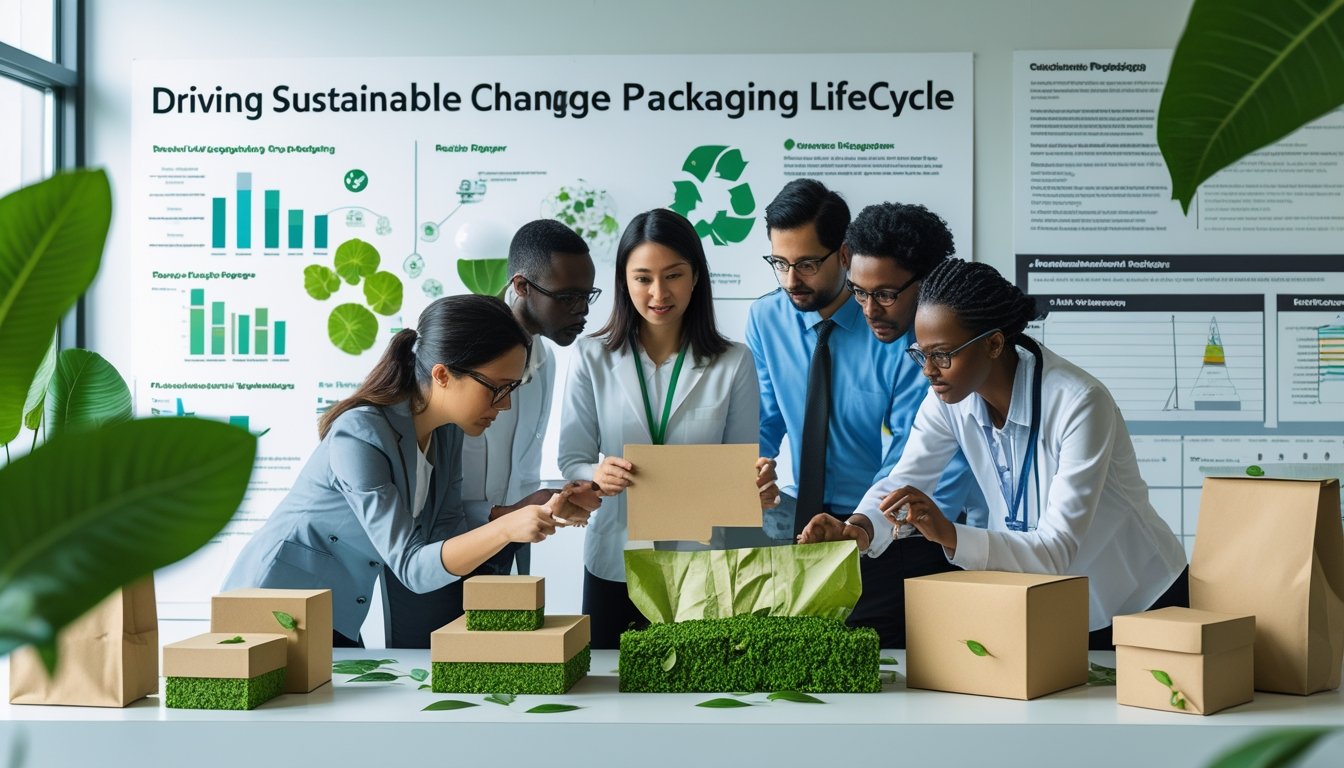Late updated: 16 Oct 2025 13:10
Written by: Amber Collins
Exploring Eco-Friendly Packaging Innovations: A Future-Ready Approach
As our world becomes increasingly aware of environmental challenges, the spotlight on sustainable practices has never been brighter. We are witnessing a shift in how packaging is viewed, from being merely functional to serving as a beacon of ecological responsibility. Eco-friendly packaging innovations are at the heart of this transformation, addressing the environmental impact of traditional packaging methods.

The packaging industry is undergoing a transformation driven by both necessity and consumer demand. Numerous brands and companies are exploring sustainable solutions that align with the global move towards sustainability. Embracing eco-friendly packaging not only minimises waste but also paves the way for a greener future, where businesses can thrive without compromising the planet.
People around the globe are becoming far more conscientious about their choices and their environmental impact. By choosing sustainable packaging solutions, they can contribute positively to the environment and support brands that prioritise sustainability. These innovative solutions show that being environmentally responsible is more than a trend—it's the future of packaging.
Key Takeaways
- Eco-friendly packaging reduces environmental impact.
- Innovations in packaging are crucial for sustainability.
- Consumers want brands to lead sustainable changes.
Key Innovations in Eco-Friendly Packaging
Eco-friendly packaging innovations are transforming the way we reduce plastic waste and promote sustainability. Innovations in biodegradable materials, bioplastics, and smart technologies are driving change in the industry, offering alternatives that reduce environmental impact without compromising function.
Breakthrough Biodegradable and Compostable Materials
Recent advances in biodegradable and compostable materials offer significant potential for reducing plastic pollution. Materials like corn starch and sugarcane represent a shift towards harnessing natural resources. These materials can decompose in compost settings, reducing waste and returning nutrients to the soil.
Packaging made from these materials caters to environmentally conscious consumers and businesses aiming for sustainable packaging solutions. With increased use in food packaging, these alternatives cut down reliance on traditional plastics. Their role in reducing the impact of single-use plastics is becoming more critical as demand for greener alternatives grows.
Emergence of Bioplastics and Biopolymers
As environmental concerns heighten, bioplastics and biopolymers are emerging as feasible alternatives to conventional plastics. Derived from renewable sources like plants, these materials are designed to be biodegradable and contribute to a circular eco-friendly economy.
It's our responsibility to harness the potential of bioplastics in reducing plastic waste, especially in the realm of food packaging. The production processes for bioplastics are becoming more sophisticated, enhancing the material's recyclability and functional properties, making them suitable for diverse packaging applications.
Smart Packaging Technologies for Sustainability
Smart packaging technologies are revolutionising the way products are packaged and consumed. Innovations such as QR codes are enabling consumers to access detailed product information, enhancing transparency and traceability in the supply chain.
This approach not only optimises the recyclability of materials but also reduces the overall carbon footprint. The integration of technology into packaging ensures products are stored in optimal conditions, extending shelf life and reducing waste. As we continue to evolve, smart packaging will play a pivotal role in sustainable packaging strategies.
Edible and Water-Soluble Packaging Solutions
In our quest for sustainable packaging, edible packaging offers a unique solution by eliminating waste altogether. Materials derived from biodegradable polymers are used to create packaging that is safe for consumption.
Similarly, water-soluble solutions provide an effective alternative by dissolving after use, reducing the impact of plastic packaging on the environment. Such innovations cater to the demand for eco-friendly materials that minimise pollution and enhance the biodegradability of packaging products. Implementing these solutions will help mitigate the effects of single-use plastics and contribute to a more sustainable future.
Driving Sustainable Change Across the Packaging Lifecycle

Sustainable change in the packaging industry requires a multifaceted approach, tackling everything from material choices to consumer demands. By focusing on circular economy principles and waste reduction, and recognising the influence of regulations and collaborative efforts, we can create an effective strategy for eco-friendly packaging innovations.
Circular Economy Principles in Packaging
The circular economy model transforms how we view packaging by closing the loop on product lifecycles. This involves using packaging materials that can be reused, recycled, or composted, thus reducing waste. Manufacturers and retailers play a key role by designing products with end-of-life disposal in mind. A significant component involves using renewable materials, creating reusable systems, and promoting recycling efficiency. Our goal revolves around reducing the carbon footprint and minimising environmental impact.
By focusing on renewable resources and reducing reliance on new raw materials, we not only conserve resources but also lower greenhouse gas emissions. This approach requires coordinated efforts among all stakeholders to ensure packaging is kept within the economic cycle for as long as possible.
Waste Reduction Strategies and Packaging Design
Innovative packaging design is vital in combatting waste. By rethinking how packaging is made and used, we can prevent waste from being created in the first place. Eco-design principles, such as minimalistic designs and right-sizing, help in cutting down on packaging waste.
Adopting materials that are lightweight yet strong can lead to significant reductions in resource consumption and waste production. Furthermore, waste management practices need to be aligned with design innovations to maximise material recovery. Extended producer responsibility (EPR) shifts accountability to manufacturers, encouraging them to take on a proactive role in waste reduction.
Collaborative Efforts Among Stakeholders
Achieving genuine sustainability requires collaboration across the industry and beyond. Manufacturers, waste management companies, governments, and consumers need to work together. Stakeholder partnerships can result in shared resources, improved supply chain coordination, and pooled knowledge for advancing packaging innovations.
By sharing data and best practices, stakeholders can develop synergistic solutions that reach beyond individual company initiatives. Open dialogues enhance transparency and trust, enabling us to address challenges collectively. This collaboration encourages investments in sustainable technologies and fosters sector-wide changes.
Regulatory and Consumer Influences on Packaging Innovation
Regulations and consumer preferences wield significant influence over packaging innovation. Governments set laws that necessitate compliance with environmental standards, pushing companies towards greener practices. Regulated limitations on harmful materials encourage the development and adoption of more sustainable alternatives.
Meanwhile, environmentally conscious consumers demand products that reflect their values. This consumer demand pushes companies to innovate and offer eco-friendly options. As such, understanding consumer behaviour aids in designing solutions that not only meet regulatory requirements but also cater to market needs. Addressing both regulatory mandates and consumer expectations is vital for driving sustainable change.
Frequently Asked Questions

In this section, we address key inquiries that consumers and businesses often have regarding eco-friendly packaging innovations. The focus is on material advancements, recyclability improvements, consumer behaviour impacts, the life cycle of packaging materials, design considerations, and regulatory challenges.
What are the latest developments in biodegradable packaging materials?
Recent advancements highlight the use of natural fibres and plant-based polymers. These innovative materials break down more efficiently, reducing landfill waste. They're designed to perform as well as traditional materials while providing environmental benefits.
How is technology advancing the recyclability of packaging products?
Technological innovations aim to enhance recycling processes, making them more efficient and effective. Improved sorting technologies and new, easily recyclable materials help increase recycling rates, reducing the ecological footprint of packaging.
What role does consumer behaviour play in the adoption of sustainable packaging solutions?
Consumer demand substantially drives the transition to sustainable packaging. As awareness grows, more individuals prioritise eco-friendly options, encouraging companies to adopt greener practices. This shift is crucial for the wider acceptance of sustainable solutions.
How are companies assessing the life cycle impact of eco-friendly packaging?
Businesses use life cycle assessments to evaluate the environmental impact of their packaging. This process considers all stages, from production to disposal, helping companies identify areas for improvement and reduce their environmental footprint.
In what ways can packaging design contribute to environmental sustainability?
Effective design can significantly enhance environmental sustainability. This includes minimising material usage, incorporating reusable elements, and ensuring ease of recyclability. Thoughtful design choices can lead to substantial reductions in waste and resource consumption.
What are the regulatory challenges facing the introduction of new eco-friendly packaging materials?
Regulatory hurdles can slow the adoption of new materials. Innovating within the constraints of existing regulations requires careful planning. Companies must navigate compliance issues to introduce sustainable packaging solutions without compromising safety or effectiveness.
